Related Research Articles
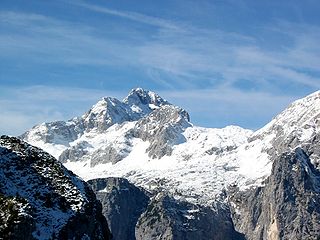
Triglav, with an elevation of 2,863.65 metres (9,395.2 ft), is the highest mountain in Slovenia and the highest peak of the Julian Alps. The mountain is the pre-eminent symbol of the Slovene nation. It is the centrepiece of Triglav National Park, Slovenia's only national park. Triglav was also the highest peak in Yugoslavia before Slovenia's independence in 1991.

The national flag of Slovenia features three equal horizontal bands of white (top), blue, and red, with the coat of arms of Slovenia located in the upper hoist side of the flag centred in the white and blue bands. The coat of arms is a shield with the image of Mount Triglav, Slovenia's highest peak, in white against a blue background at the centre; beneath it are two wavy blue lines representing the Adriatic Sea and local rivers, and above it are three six-pointed golden stars arranged in an inverted triangle which are taken from the coat of arms of the Counts of Celje, the great Slovene dynastic house of the late 14th and early 15th centuries.

"Zdravljica" is a carmen figuratum poem by the 19th-century Romantic Slovene poet France Prešeren, inspired by the ideals of Liberté, égalité, fraternité. It was written in 1844 and published with some changes in 1848. Four years after it was written, Slovenes living within Habsburg Empire interpreted the poem in spirit of the 1848 March Revolution as political promotion of the idea of a united Slovenia. In it, the poet also declares his belief in a free-thinking Slovene and Slavic political awareness. In 1989, it was adopted as the anthem of Slovenia, becoming the national anthem upon independence in 1991.

"Hey, Slavs" is a patriotic song dedicated to the Slavs and widely considered to be the Pan-Slavic anthem. It was adapted and adopted as the national anthem of various Slavic-speaking nations, movements and organizations during the late 19th and 20th century.

The Slovenes, also known as Slovenians, are a South Slavic ethnic group native to Slovenia, and adjacent regions in Italy, Austria and Hungary. Slovenes share a common ancestry, culture, history and speak Slovene as their native language. They are closely related to other South Slavic ethnic groups, as well as more distantly to West Slavs.
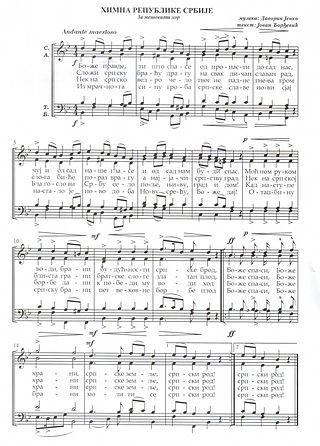
"Bože pravde" is the national anthem of Serbia, as defined by the Article 7 of the Constitution of Serbia. "Bože pravde" was the state anthem of the Kingdom of Serbia until 1919 when Serbia became a part of the Kingdom of Serbs, Croats and Slovenes. It was re-adopted as the national anthem at first by the parliamentary recommendation on the use in 2004 and then constitutionally sanctioned in 2006, after Serbia became independent again.
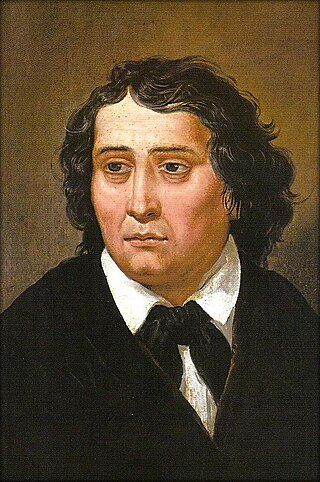
France Prešeren was a 19th-century Romantic Slovene poet whose poems have been translated into many languages.

Simon Jenko was a Slovene poet, lyricist and writer.
Onamo 'namo! is a patriotic song written by Prince Nicholas of Montenegro and first published in the Novi Sad-based Serbian-language literary journal Danica in 1867. Its melody can be attributed either to the Slovene composer Davorin Jenko or the Czech chaplain František Wimmer, the conductor of the Royal Montenegrin Army's military band.
The "National anthem of the Kingdom of Yugoslavia" was created in December 1918 from the national anthems of the Kingdom's three historical constituent lands: Kingdom of Croatia-Slavonia (Croatia), Kingdom of Serbia (Serbia) and Duchy of Carniola (Slovenia).
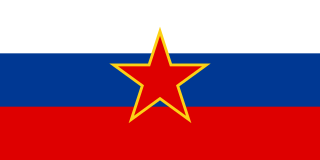
The Socialist Republic of Slovenia, commonly referred to as Socialist Slovenia or simply Slovenia, was one of the six federal republics forming Yugoslavia and the nation state of the Slovenes. It existed under various names from its creation on 29 November 1945 until 25 June 1991.

Jovan Đorđević was a Serbian writer, dramatist, Minister of Education and the co-founder of the Novi Sad Serbian National Theatre in 1861, the National Theatre in Belgrade in 1868 and the Academy of Dramatic Art in 1870. He is most famous for writing the lyrics to the Serbian National anthem Bože pravde in 1872. He was also a member of Matica Srpska.

France Balantič was a Slovene poet. His works were banned from schools and libraries during the Titoist regime in Slovenia, but since the late 1980s he has been re-evaluated as one of the foremost Slovene poets of the 20th century.
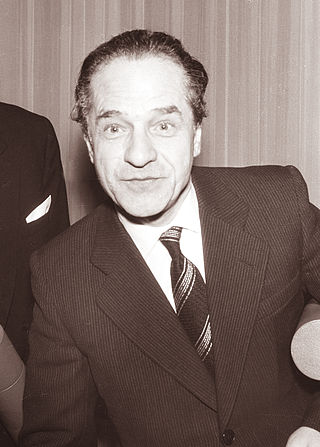
Dragotin Cvetko was a Slovenian composer and musicologist.
The Venetic theory is a pseudohistorical interpretation of the origin of the Slovenes that denies the Slavic settlement of the Eastern Alps in the 6th century, claiming that proto-Slovenes have inhabited the region since ancient times. During the 1980s and 1990s, it gained wide attention in Slovenia and the former Yugoslavia. The Venetic theory has been rejected by scholars.

The national anthem of Slovenia is based on "Zdravljica", a carmen figuratum poem by the 19th-century Romantic Slovene poet France Prešeren, inspired by the ideals of Liberté, égalité, fraternité, and set to music by Stanko Premrl. As the country's national anthem, it is one of the state symbols of Slovenia.

Davorin Jenko was a Slovene composer. He is sometimes considered the father of Slovenian national Romantic music. Among other songs, he composed the melody for the Serbian national anthem "Bože pravde", the former Slovenian national anthem "Naprej, zastava Slave", and the popular Serbian and Montenegrin song "Serbian Marseillaise".

Svetlana Makarovič is a Slovenian writer of prose, poetry, children's books, and picture books, and is also an actress, illustrator and chanteuse. She has been called "The First Lady of Slovenian poetry." She is also noted for borrowing from Slovenian folklore to tell stories of rebellious and independent women. She is well-known adult and youth author. Her works for youth have become a part of modern classic and youth canon, which both hold a special place in history of the Slovenian youth literature. She won the Levstik Award for Lifetime Achievement in 2011.
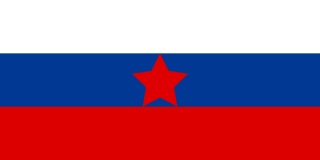
The Slovene Partisans, formally the National Liberation Army and Partisan Detachments of Slovenia, were part of Europe's most effective anti-Nazi resistance movement led by Yugoslav revolutionary communists during World War II, the Yugoslav Partisans. Since a quarter of Slovene ethnic territory and approximately 327,000 out of total population of 1.3 million Slovenes were subjected to forced Italianization since the end of the First World War, the objective of the movement was the establishment of the state of Slovenes that would include the majority of Slovenes within a socialist Yugoslav federation in the postwar period.
References
- 1 2 Kristen, Samo (2007). "V Pragi "Naprej zastava slave", v Ljubljani "Kde domov můj?" Jan Masaryk in Slovenci" [In Prague "Naprej zastava slave", in Ljubljana "Kde domov můj?" Jan Masaryk and Slovenes](PDF). Anthropos (in Slovenian). 39 (3–4): 272–274. ISSN 0587-5161. COBISS 11065421.
- 1 2 Luka Lisjak Gabrijelčič (2008). The Dissolution of the Slavic Identity of the Slovenes in the 1980s. The case of the Venetic Theory (PDF) (Master thesis). Central European University. p. 34.
- 1 2 Rupnik, Janko; Cijan, Rafael; Grafenauer, Božo (1993). Ustavno pravo [Constitutional Law] (in Slovenian). Faculty of Law, University of Maribor. p. 51. ISBN 978-961-6009-39-3.
- ↑ Javornik, Marijan, ed. (2001). Enciklopedija Slovenije [Encyclopedia of Slovenia] (in Slovenian). Vol. 15. p. 403. ISBN 978-86-11-14288-3.
- ↑ "Državni simboli in znamka Slovenije" [National Symbols and the Trademark of Slovenia] (in Slovenian). Government Communication Office of the Republic of Slovenia. 2011. Retrieved 3 March 2012.
- 1 2 Menart, Janez (1972). "Premislek ob slovenski himni" [Consideration at the Slovene Anthem]. Sodobnost (in Slovenian). Državna založba Slovenije [National Publishing House of Slovenia]. 20 (3): 325. ISSN 0038-0482.
- 1 2 3 Dobrovoljc, France (1951). "Razgledi: dve zanimivi epizodi iz zgodovine slovensko-angleških kulturnih stikov" [Views: Two Interesting Episodes from the History of the Slovene-English Cultural Contacts]. Novi svet [New World] (in Slovenian). Državna založba Slovenije [State Publishing House of Slovenia]. 6 (10): 958–959. ISSN 1318-2242. COBISS 37239808.
- 1 2 "II. Prosvetni veljaki: Skladatelj Davorin Jenko: 1835.–1914" [II. Educational Personages]. Od Ilirije do Jugoslavije: spomenica Davorin Jenkove narodne šole v Cerkljah pri Kranju [From Illyria to Yugoslavia: the Memorandum of the Davorin Jenko's Popular School in Cerklje near Kranj] (in Slovenian). 1931. pp. 60–61. COBISS 2765878.
- ↑ Tomaževič, Blaž (1957). "Motivi in oblika Jenkove poezije" [Motives and the Form of Jenko's Poetry]. Jezik in slovstvo [Language and Literature] (in Slovenian). Slavistično društvo Slovenije [Slavic Society of Slovenia]. 2 (2). ISSN 0021-6933. COBISS 242784768.
- ↑ "Pogled po slovanskem svetu: slovenske dežele" [A View Across the Slavic World: Slovene Lands]. Slovan: Političen in Leposloven List (in Slovenian). Narodna tiskarna [National Publishing House]. 2 (10): 159. 15 May 1885. ISSN 1408-0214. COBISS 37253889.
- ↑ "Davorin Jenko je na Dunaju zložil napev pesmi Naprej, zastava slave Simona Jenka" [In Vienna, Davorin Jenko Composed the Melody of the Poem Forward, the Flag of Glory by Simon Jenko] (in Slovenian). Zgodovinsko društvo dr. Franca Kovačiča v Mariboru [Historical Society dr. Franc Kovačič in Maribor]. Retrieved 3 March 2012.
- 1 2 3 Bric, Roman (11 June 2010). "Himna Slovenske vojske je nastala pred 150 leti" [The Anthem of the Slovene Armed Forces Was Made 150 Years Ago](PDF). Slovenska vojska [Slovene Armed Forces] (in Slovenian and English). XVIII (9): 26–27. ISSN 1318-0681. COBISS 256918784.
- ↑ "Anthem". The Lexicon of Yugoslavia. Archives of Yugoslavia. 2008. Retrieved 3 March 2012.
- ↑ "Na današnji dan od 15. 11. 2010 do 21. 11. 2010" [On This Day From 15 November 2010 Until 21 November 2010]. MMC RTV Slovenia: 1. program Radia Slovenija [MMC RTV Slovenia: 1st Program of the Radio Slovenia (in Slovenian). RTV Slovenija. 15 November 2010.
- ↑ Lešnik, Doroteja; Tomc, Gregor (1995). Rdeče in črno: slovensko partizanstvo in domobranstvo [Red and Black: Slovene Partisans and the Slovene Home Guard] (in Slovenian). Znanstveno in publicistično središče [Scientific and Journalistic Centre]. p. 85. ISBN 978-961-6014-60-1.